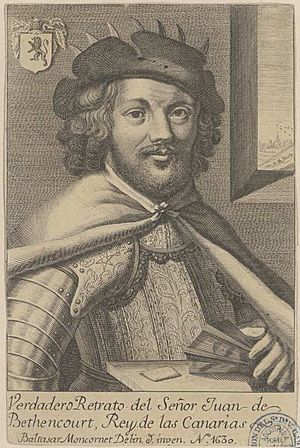Jean de Béthencourt facts for kids
Quick facts for kids Jean de Béthencourt |
|
|---|---|

A later depiction of Jean de Béthencourt.
|
|
| King of the Canary Islands | |
| Reign | 1404–1425 |
| Born | 1362 Grainville-la-Teinturière, Kingdom of France |
| Died | 1425 Kingdom of the Canary Islands |
| Religion | Catholicism |
Jean de Béthencourt (born 1362, died 1425) was a French explorer. In 1402, he led a trip to the Canary Islands. He first landed on the north side of Lanzarote island.
From there, he took control of Fuerteventura (in 1405) and El Hierro. He removed the local leaders, known as majos and bimbaches. Béthencourt was given the title of King of the Canary Islands. However, he recognized King Henry III of Castile as his ruler. King Henry had helped him during his conquests.
Contents
The Canary Islands' Past
The Canary Islands were known to people long ago. The Carthaginians from Cadiz seemed to know about them. A Roman writer named Pliny the Elder called them "the Fortunate Islands".
Later, in 1312, a sailor from Genoa named Lancelotto Malocello is thought to have found the Canary Islands again. In 1339, Angelino Dulcert from Majorca drew the first map of the islands. He named one of them "Lanzarote".
Jean de Béthencourt's Life
Jean de Béthencourt was also known as the Baron of Saint-Martin-le-Gaillard. He was born in Grainville-la-Teinturière, in the Normandy region of France. His parents were Jean III Béthencourt and Marie de Bracquemont.
Jean's father died in 1364 during the Battle of Cocherel. Jean was still a child at that time. In 1365, his family's castle in Grainville was torn down. This happened because King Charles V of France ordered castles to be destroyed if their owners supported his enemies.
In 1377, when he was fifteen, Béthencourt started working for Louis I, Duke of Anjou. He became a squire, which was a knight's assistant. From 1387 to 1391, he held an important position for Louis de Valois. In 1387, King Charles VI of France allowed him to rebuild his castle in Grainville.
As the lord of Grainville, Béthencourt controlled seven parishes. He also had rights over goods that passed through his land. He was a vassal, or loyal follower, of the Count of Longueville. Later, he served Henry V of England when England took control of parts of France. During these unstable times, Béthencourt likely took advantage of the situation. In 1392, he married Jeanne de Fayel in Paris.
The Siege of Mahdia
In 1390, Jean de Béthencourt joined a military trip called the Barbary Crusade. This trip was organized by merchants from Genoa. They wanted to stop pirates from North Africa. The trip was presented as a crusade, which meant it would bring honor and rewards to those who joined.
The French forces, led by Louis II, Duke of Bourbon, tried to capture the city of Mahdia in Tunis. The French were not used to the land and did not have enough heavy equipment. They also had disagreements among themselves. The local people realized they could not defeat the French directly.
Eventually, both sides grew tired. The French were hot and worried about winter. They agreed to a peace treaty that the Genoese helped to arrange.
During this time, Béthencourt probably heard stories about the Canary Islands. He also learned about orchil, a special plant used to make a rare and expensive dye. He also met Gadifer de la Salle again, whom he knew from earlier service. Gadifer would later join him on his trip to the Canaries.
Journey to the Canary Islands
At this time, Spanish merchants often visited the Canary Islands. To pay for his trip, Béthencourt sold his house in Paris and other small properties in 1401. His cousin, Robert de Bracquemont, who was a French ambassador, loaned him money.
Béthencourt left La Rochelle on May 1, 1402. He had 280 men with him, mostly adventurers from Gascony and Normandy. Two Franciscan priests, Pierre Bontier and Jean le Verrier, were also on board. They wrote down the story of the trip in a book called Le Canarien. Two native Guanches who had been captured earlier and baptized also joined. Jean Arriete Prud'homme, an important helper, also came along.
After passing Cape Finisterre, they stopped in Cadiz. Some of his sailors were so scared that they refused to continue. Béthencourt started with eighty crew members but sailed on with only fifty-three. He arrived at Lanzarote, the northernmost island where people lived.
While Gadifer de la Salle explored the other islands, Béthencourt went to Cádiz. He wanted to get more supplies and men from the Castilian court. During his absence, some disagreements and fighting broke out among his men and with local leaders on the island. Many people died.
Gadifer managed to take control of Fuerteventura and explore other islands during this time. Peace returned to Lanzarote only when Béthencourt came back in 1404. De la Salle and Béthencourt then founded the city of Betancuria in 1404. This city became the capital of Fuerteventura.
Years later, Béthencourt was defeated by the native people of Gran Canaria. This happened in the battle of Arguineguin, in the south of the island.
Jean de Béthencourt died in 1425. He was buried in the church of Grainville-la-Teinturière.
The Béthencourt Name
Even today, the surname Betancourt and similar spellings are common among Canary Islanders. This is true even though Jean de Béthencourt did not have children of his own. This happened because native people were often given his surname when they were baptized. Also, his nephew, Maciot de Béthencourt, took over as lord of the islands and had many descendants.
See also
 In Spanish: Jean IV de Béthencourt para niños
In Spanish: Jean IV de Béthencourt para niños
- Roccella tinctoria


